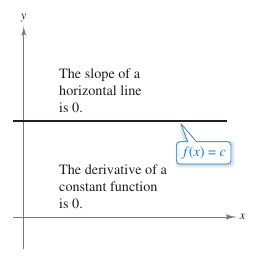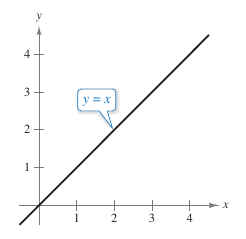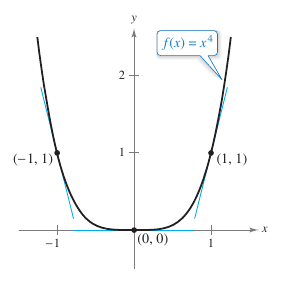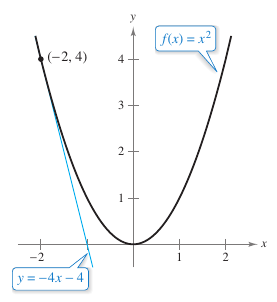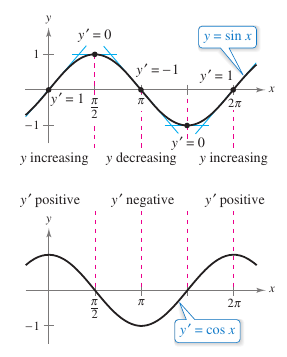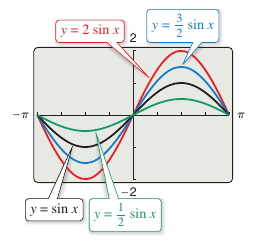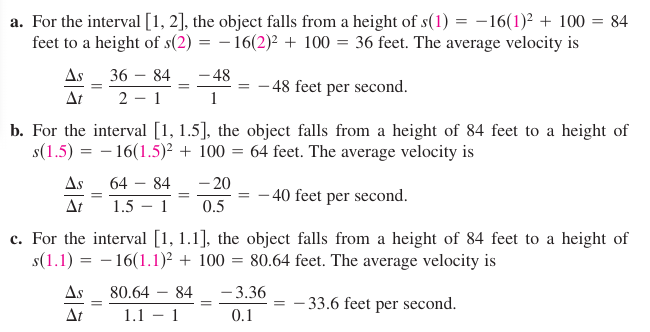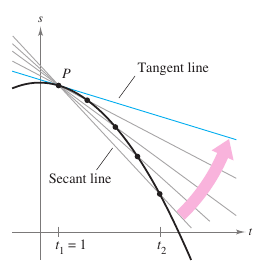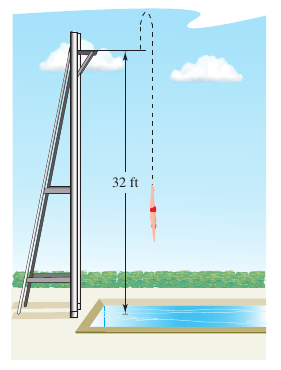Calculus I 02.02 Basic Differentiation Rules and Change Rate
| Previous | Calculus I 02.01 The_Derivative and the Tangent Line Problem |
| Next | Calculus I 02.03 Product_Rule,_Quotient Rule, and Higher-Order Derivatives |
Contents
Basic Differentiation Rules and Change Rate
- Find derivatives using the Constant, Constant Multiple, Power, and Sum and Difference Rules.
- Find derivatives for Change Rates
The Constant Rule
A derivative can be found by indirect means. One is the Constant Rule.
Theorem 2.2.1 The Constant Rule
|
|
The derivative for a constant function is zero. That is, if \(c\) is a real number, then
as shown in Figure 2.2.1.
|
Example 2.2.1 Using the Constant Rule
| Function | Derivative |
|---|---|
| a.\(y=7\) | \(dy/dx=0\) |
| b.\(f(x)=0\) | \({f}'(x)=0\) |
| c.\(s(x)= -3\) | \({s}'(t)=0\) |
| d.\(y=k\pi^2, \:k \text{ is a constant}\) | \({y}'=0\) |
The Simple Power Rule
Consider the procedure for expanding a binomial.
- \((x+\Delta x)^2=x^2+2x\Delta x + (\Delta x)^2\)
- \((x+\Delta x)^3=x^3+3x^2\Delta x + 3x(\Delta x)^2+(\Delta x)^3\)
- \((x+\Delta x)^4=x^4+4x^3\Delta x + 6x^2(\Delta x)^2+4x(\Delta x)^3+(\Delta x)^4\)
- \((x+\Delta x)^5=x^5+5x^4\Delta x + 10x^3(\Delta x)^2+10x^2(\Delta x)^3+5x(\Delta x)^4+(\Delta x)^5\)
The general binomial expansion for a positive integer \(n\) is
- $$(x+\Delta x)^n=x^n+nx^{n-1}(\Delta x)+\color{red}{\underbrace{\color{black}{ \frac{n(n-1)x^{n-2}}{2}(\Delta x)^2+...+(\Delta x)^n. }}_{\color{red}{(\Delta x)^2\text{ is a factor for these terms.}}}} $$
This binomial expansion is used in proving a special case, The Power Rule.
Theorem 2.2.2 The Simple Power Rule
If \(n\) is a rational number, then the function \(f(x)=x^n\) is differentiable and
- $$\frac{d}{dx}[x^n]=n x^{n-1}.$$
For \(f\) to be differentiable at \(x=0\), \(n\) must be a number such that \(x^{n-1}\) is defined on an interval containing zero.
Proof If \(n\) is a positive integer greater than one, then the binomial expansion produces
|
$$=\lim_{\Delta x \to 0}\frac{x^n+nx^{n-1}(\Delta x)+\frac{n(n-1)x^{n-2}}{2}(\Delta x)^2+...+(\Delta x)^n-x^n}{\Delta x}$$ |
|
$$=\lim_{\Delta x \to 0} \left [ nx^{n-1}+\frac{n(n-1)x^{n-2}}{2}(\Delta x)+...+(\Delta x)^{n-1} \right ]$$ | |
|
\(=nx^{n-1}+0+...+0\) | |
| \(=nx^{n-1}.\) |
This proves the case for which n is a positive integer greater than one. The case for \(n=1\) is left as an exercise. Example 2.3.7 proves the case for which \(n\) is a negative integer. In Section 5.5 the Power Rule is extended to irrational values for \(n\).
|
|
When using the Power Rule, the case for which \(n=1\) is a special case for the Power Rule. That is,
This rule is consistent with fact that the slope for the line \(y=x\) is one, as shown in Figure 2.2.2. |
Example 2.2.2 Using the Power Rule
| Function | Derivative | |
|---|---|---|
| a. | \(f(x)=x^3\) | \({f}'(x)=3x^2\) |
| b. | \(g(x)=\sqrt[3]{x}\) |
$${g}'(x)=\frac{d}{dx}[x^{1/3}]=\frac{1}{3}x^{-2/3}=\frac{1}{3x^{2/3}}$$ |
| c. |
$$y=\frac{1}{x^2}$$ |
$$\frac{dy}{dx}= \frac{d}{dx}[x^{-2}]=(-2)x^{-3}=-\frac{2}{x^3}$$ |
In Example 2.2.2(c), note that before differentiating, \(1/x^2\) was written as \(x^{-2}\). Rewriting is the first step in many differentiation problems.
| Given: | Rewrite: | Differentiate: | Simplify: |
|
$$y=\frac{1}{x^2}$$ |
$$y=x^{-2}\:\:\:\:$$ |
$$\frac{dy}{dx}=(-2)x^{-3}$$ |
$$\frac{dy}{dx}=-\frac{2}{x^3}$$ |
Example 2.2.3 Finding the Slope for a Graph
|
|
Find the slope for the graph for
for each value below.
Solution The slope for a graph at a point is the derivative's value at that point. The derivative for \(f\) is \({f}'(x)=4x^3\).
This is shown in Figure 2.2.3. |
Example 2.2.4 Finding an Equation for a Tangent Line
|
|
Find an equation for the tangent line to the graph for \(f(x)=x^2\) when \(x=-2\).
To find the slope when \(x=-2\) evaluate the derivative, \({f}'(x)=2x\), at \(x=-2\).
Use the point-slope equation for a line and rewrite it as:
as shown in Figure 2.2.4. |
The Constant Multiple Rule
Theorem 2.2.3 The Constant Multiple Rule
If \(f\) is a differentiable function and \(c\) is a real number, then \(cf\)is also differentiable and
- $$\frac{d}{dx}[cf(x)]=c{f}'(x).$$
Proof
|
$$= \lim_{\Delta x \to 0} \frac{cf(x+\Delta x)-cf(x)}{\Delta x}$$ | Derivative Definition |
|
$$= \lim_{\Delta x \to 0}c \left [ \frac{f(x+\Delta x)-f(x)}{\Delta x} \right ]$$ | ||
|
$$= c\left [ \lim_{\Delta x \to 0} \frac{f(x+\Delta x)-f(x)}{\Delta x} \right ]$$ |
Theorem 1.3.2 | |
| \(=c{f}'(x)\) |
The Constant Multiple Rule, simplified, states that constants can be factored from differentiation equation, as shown below
Example 2.2.5 Using the Constant Multiple Rule
Before differentiating functions involving radicals, rewrite the function with rational exponents.
| Function | Derivative | |
|---|---|---|
| a. |
\(y=5x^3\) |
$$\frac{dy}{dx}=\frac{d}{dx}[5x^3]=5\frac{d}{dx}[x^3]=5(3)x^2=15x^2$$ |
| b. |
$$y=\frac{2}{x}$$ |
$$\frac{dy}{dx}=\frac{d}{dx}[2x^{-1}]=2\frac{d}{dx}[x^{-1}]=2(-1)x^{-2}=-\frac{2}{x^2}$$ |
| c. |
$$f(t)=\frac{4t^2}{5}$$ |
$${f}'(t)= \frac{d}{dt}\left [ \frac{4}{5} t^2 \right ]=\frac{4}{5}(2t)=\frac{8}{5}t$$ |
| d. |
\(y=2\sqrt{x}\) |
$$\frac{dy}{dx}=\frac{d}{dx} \left [ 2x^{1/2} \right ]= 2 \left ( \frac{1}{2} x^{-1/2} \right ) = \frac{1}{\sqrt{x}}$$ |
| e. |
$$y=\frac{1}{2\sqrt[3]{x^2}}$$ |
$$\frac{dy}{dx}=\frac{d}{dx} \left [ \frac{1}{2}x^{12/3} \right ]= \frac{1}{2} \left ( -\frac{2}{3} \right ) x^{-5/3}= -\frac{1}{3x^{5/3}}$$ |
| f. |
$$y=-\frac{3x}{2}$$ |
$${y}'=\frac{d}{dx} \left [ -\frac{3}{2}x \right ] = -\frac{3}{2}(1) = -\frac{3}{2}$$ |
The Constant Multiple and Power Rules can be combined into one.
- $$\frac{d}{dx} [cx^n]=cnx^{n-1}.$$
Example 2.2.6 Using Parentheses When Differentiating
| Original Function | Rewrite | Differentiate | Simplify | |
|---|---|---|---|---|
| a. |
$$y=\frac{5}{2x^3}$$ |
$$y=\frac{5}{2}(x^{-3})$$ |
$${y}'=\frac{5}{2}(-3x^{-4})$$ |
$${y}'=-\frac{15}{2x^4}$$ |
| b. |
$$y=\frac{5}{(2x)^3}$$ |
$$y=\frac{5}{8}(x^{-3})$$ |
$${y}'=\frac{5}{8}(-3x^{-4})$$ |
$${y}'=-\frac{15}{8x^4}$$ |
| c. |
$$y=\frac{7}{3x^{-2}}$$ |
$$y=\frac{7}{3}(x^2)$$ |
$${y}'=\frac{7}{3}(2x)$$ |
$${y}'=\frac{14x}{3}$$ |
| d. |
$$y=frac{7}{(3x)^{-2}}$$ |
\(y=63(x^2)\) |
\({y}'=63(2x)\) |
\({y}'=126x\) |
The Sum and Difference Rules
Theorem 2.2.4 The Sum and Difference Rules
The sum or difference between two differentiable functions \(f\) and \(g\) is itself differentiable. In addition the derivative for \(f+g\) or \(f-g\) is the sum or difference between the derivatives for \(f\) and \(g\).
|
Sum Rule |
|
Difference Rule |
Proof The Sum Rule follows from Theorem 1.3.2. So does the Difference Rule.
|
$$=\lim_{\Delta x \to 0} \frac{ [f(x+\Delta x) +g(x+\Delta x)]-[f(x)+g(x)]}{\Delta x}$$ |
|
$$=\lim_{\Delta x \to 0} \frac{ f(x+\Delta x) +g(x+\Delta x)-f(x)-g(x)}{\Delta x}$$ | |
|
$$=\lim_{\Delta x \to 0} \left [ \frac{ f(x+\Delta x)-f(x)}{\Delta x} +\frac{g(x+\Delta x)-g(x)}{\Delta x} \right ]$$ | |
|
$$=\lim_{\Delta x \to 0} \frac{ f(x+\Delta x)-f(x)}{\Delta x} +\lim_{\Delta x \to 0} \frac{g(x+\Delta x)-g(x)}{\Delta x} $$ | |
| \({f}'(x)+{g}'(x)\) |
The Sum and Difference Rules can be extended to any compound expression with a finite function count. For example, if
- \(F(x)=f(x)+g(x)-h(x)\), then \({F}'(x)={f}'(x)+{g}'(x)-{h}'(x).\)
Example 2.2.7 Using the Sum and Difference Rules
| Function | Derivative | |
|---|---|---|
| a. | \(f(x)=x^3-4x+5\) | \({f}'(x)=3x^2-4\) |
| b. |
$$g(x)=-\frac{x^4}{2}+3x^3-2x$$ |
\({g}'(x)=-2x^3+9x^2-2\) |
| c. |
$$y=\frac{3x^2-x+1}{x}=3x-1+\frac{1}{x}\:\:\:\:$$ |
$${y}'=3-\frac{1}{x^2}=\frac{3x^2-1}{x^2}$$ |
Derivatives with Sine and Cosine Function
|
|
Section 1.3 described the limits
These limits can be used to prove differentiation rules for sine and cosine functions. Section 2.3 describes differentiation rules for the other four trigonometric functions. Theorem 2.2.5 Derivatives of Sine and Cosine Functions
Proof This proves the first rule. The second rule is proved in a similar manner.
Note that for each \(x\), the slope for the sine curve is equal to the value for cosine, as shown in Figure 2.2.5 |
Example 2.2.8 Derivatives Involving Sines and Cosines
|
|
| |||||||||||||||
Change Rate
The derivative can also be used to determine the change rate between two variables. Applications involving change rates, sometimes referred to as instantaneous change rate, occur in many fields. A few examples are population growth rates, production rates, water flow rates, velocity, and acceleration. A common use for change rates is to describe an object's motion moving in a straight line. It is customary to use either a horizontal or a vertical line with a designated origin to represent the motion. Movement to the right, or upward, is considered a positive direction, and movement to the left, or downward, is considered a negative direction.
The function \(s\) that gives the position, relative to the origin, for an object as a function with time \(t\) is called a position function. If, over a time period \(\Delta t\), the object changes its position by the amount
- \(\Delta s=s(t+\Delta t)-s(t)\)
- \(\Delta s=s(t+\Delta t)-s(t)\)
then, by the formula
- $$\text{Rate}=\frac{\text{distance}}{\text{time}}$$
the average velocity is
|
$$\frac{\text{Change in distance}}{\text{Change in distance}}=\frac{\Delta s}{\Delta t}$$ |
Average velocity |
Example 2.2.9 Finding Average Velocity for a Falling Object
|
|
A billiard ball is dropped from a 100 foot height. The ball’s height \(s\) at time \(t\) is the position function
where \(s\) is measured in feet and \(t\) is measured in seconds. Find the average velocity over each time interval.
Solution Note the average velocities are negative, indicating the object is moving downward. |
|
|
Suppose Example 2.2.9 was to find the instantaneous velocity, or simply the velocity, for the object when \(t=1\). Just as the slope for a tangent line is approximated by calculating the slope for the secant line, the velocity at \(t=1\) you can approximated by calculating the average velocity over a small interval, say, \([1,1+\Delta t]\), as shown in Figure 2.2.8. By taking the limit as \(\Delta t\) approaches zero the velocity when \(t=1\) is produced. Try doing this—you will find that the velocity when \(t=1\) is \(-32\) feet per second. In general, if \(s=s(t)\) is the position function for an object moving along a straight line, then the velocity for the object at time \(t\) is
In other words, the velocity function is the derivative for the position function. Velocity can be negative, zero, or positive. An object's speed is the velocity's absolute value. Speed cannot be negative. The position for a free-falling object, neglecting air resistance, influenced by gravity can be represented by the equation
where \(s_0\) is the object's initial height, \(v_0\) is the initial velocity, and \(g\) is the acceleration due to gravity. On Earth, the value for \(g\) is approximately \(-32\) feet per second per second or \(-9.8\) meters per second per second. |
Example 2.2.10 Using the Derivative to Find Velocity
|
|
At time \(t=0\), a diver jumps from a platform diving board that is 32 feet above the water, as shown in Figure 2.2.9. Because the diver's initial velocity is 16 feet per second, the diver's position is
where \(s\) is measured in feet and \(t\) is measured in seconds.
a. When does the diver hit the water?
Because \(t \leq 0\), choose the positive value to conclude the diver hits the water at \(t=2\) seconds.
| |||||||||||||||||||
Internal Links
Parent Article: Calculus I 02 Differentiation
